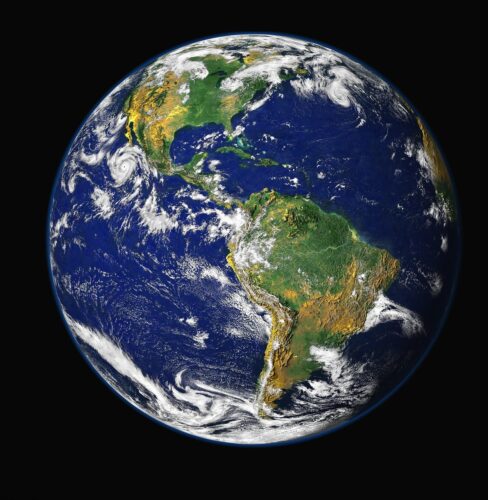The Earth is the third planet from the Sun in our solar system and is the only known celestial body to support life. Earth’s features include vast oceans, towering mountains, and a rich biodiversity. It orbits the Sun at an average distance of about 150 million kilometers and completes one rotation on its axis every 24 hours, resulting in day and night. Earth’s interconnected systems, such as the hydrosphere, atmosphere, geosphere, and biosphere, work together to create a dynamic and habitable planet.

What is the weight of Earth?
The Earth has a mass of approximately 5.97 x 1024 kilograms (1.32 × 1025 lb) i.e. 5.97 trillion trillion kilograms. The weight of an object depends on the gravitational force acting on it, so the weight of the Earth would vary depending on where the measurement is taken.
To calculate its weight, we need to multiply its mass by the gravitational acceleration at its surface, which is about 9.806 65 m/s2 (1 g; 32.1740 ft/s2) . This gives us a weight of about 5.86 × 1024 N (1.32 × 1025 lbf).
FAQs about Earth:
What is the Earth made of?
The Earth is composed of several layers. The outermost layer is the crust, which is made up of solid rock and soil. Beneath the crust lies the mantle, consisting of hot, semisolid rock. The innermost part is the core, divided into an outer liquid layer and a solid inner core, mostly made of iron and nickel.
How old is the Earth?
The Earth is estimated to be around 4.54 billion years old. This age is determined through various scientific methods, including radiometric dating of rocks and studying the ages of meteorites.
What is the Earth’s atmosphere like?
The Earth’s atmosphere is a layer of gases surrounding the planet. It primarily consists of nitrogen (about 78%) and oxygen (about 21%), with traces of other gases like carbon dioxide, argon, and water vapor. The atmosphere plays a crucial role in protecting life on Earth and regulating the planet’s climate.
Fun facts about Earth
- Earth is known as the “Blue Planet”. This is because water is abundant in Earth, covering about 71% of its surface. This water exists in the form of oceans, lakes, rivers, and ice.
- The Earth’s rotation on its axis causes day and night. It takes approximately 24 hours for the Earth to complete one rotation, resulting in a 24-hour day.
- Earth has a magnetic field generated by the motion of molten iron in its outer core. This magnetic field acts as a shield, protecting the planet from the solar wind and cosmic radiation.
- The Earth experiences four distinct seasons – spring, summer, autumn, and winter – due to the tilt of its axis as it orbits the Sun.
- The highest point on Earth is Mount Everest, standing at 8,848 meters (29,029 feet) above sea level. The lowest point is the Challenger Deep in the Mariana Trench, reaching a depth of about 11,034 meters (36,070 feet) below sea level.
- Earth has one natural satellite, the Moon, which orbits the planet every 27.3 days . The Moon is about 384,400 km (238,900 mi) away from Earth and has a diameter of about 3,474 km (2,159 mi) .
- The Earth’s atmosphere helps protect life by filtering harmful ultraviolet radiation from the Sun and providing the oxygen necessary for respiration.
The Earth is a unique and remarkable planet, providing a home for a rich variety of life and serving as a dynamic and interconnected system within the vastness of the universe.
Source:
(1) In Depth | Earth – NASA Solar System Exploration. https://solarsystem.nasa.gov/planets/earth/in-depth/.
(2) Earth – Wikipedia. https://en.m.wikipedia.org/wiki/Earth.
(3) Overview | Earth – NASA Solar System Exploration. https://solarsystem.nasa.gov/planets/earth/overview/.
(4) Earth – Wikipedia. https://en.wikipedia.org/wiki/Earth.
(5) Earth – Kids | Britannica Kids | Homework Help. https://kids.britannica.com/kids/article/Earth/353074.
Leave a Reply Cancel reply